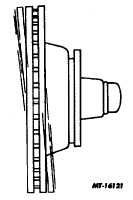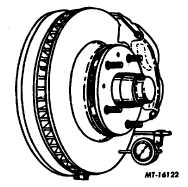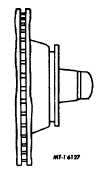|
| |
TRUCK SERVICE MANUAL
TM 5-4210-230-14&P-1
BRAKES-HYDRAULIC
and drum surface. Grind new lining approximately 1.78 mm
(.070 in.) less than the inside diameter of brake drum. Make
certain that the brake is fully released before grinding.
DISC BRAKES
INSPECTION OF ROTORS
Inspect rotors for lateral runout, parallelism, (Fig.
14), cracks or burnt marks.
The disc brakes may have a slight amount of runout
or wobble due to tolerances which are required in machining
the large flat surfaces of the rotor.
Fig. 14 Rotor Lateral Runout
Lateral runout is the movement of the rotor from side to side
as it rotates. Excessive runout causes the rotor faces to
knock back the disc pads and can result in chatter, excessive
pedal travel, pumping or fighting pedal and vibration during
the braking action. This condition can be due to a warped
rotor, loose wheel bearing and, especially if symptoms
develop immediately after sharp turns, deflection in steering
or suspension.
Runout is measured by a dial indicator SE1848 (Fig. 15) set
against the rotor surface approximately 25.4 mm (1 in.) from
outer edge of rotor. Runout should not exceed .105 mm (.
004 in.) Excessive runout will kick back the shoes, cause an
increase in pedal travel needed to apply the brakes, and pedal
vibration will be felt during applications. It also contributes to
"grab", "pull" and noise problems.
Do not overlook wheel bearing adjustment. Wheel bearings
which are loose can cause excessive runout indication.
If rotor runout exceeds .105 mm (.004 in.) either refacing or
new rotor assembly will be required.
Fig. 15 Dial Indicator Installation
Fig. 16 Rotor Not Satisfactory for Service
Rotors
should
be
inspected
for
parallelism.
Parallelism refers to the amount of variation in thickness' of
the rotor (Fig. 17).
Fig. 17 Rotor Parallelism or Variation In Thickness
CTS-2779 Page 7
PRINTED IN UNITED STATES OF AMERICA
|




